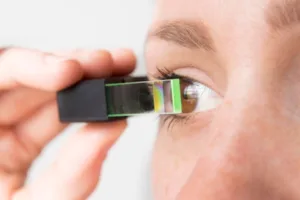A team at Fraunhofer IOF have developed a way to produce AR glasses in a smaller, less prominent form factor. These glasses – to be shown at Laser World of Photonics in Munich (22nd – 25th June) – can also correct for farsightedness.
Previous smart glass designs have used large frames and a microdisplay. The microdisplay in the new glasses is of a similar size (8 x 15mm), but the optics that project the image on the desired position are about 20% of the size: 5mm long. Instead of a single long optical component, the team uses an array of small optical elements.
Today’s AR glasses tend to project information at the edge of a user’s field of view. In Fraunhofer’s model, information is projected ‘precisely where the context dictates it should be’. A nanoscale lattice structure is applied to a glass plate, and used as a light guide. The optical image is coupled into the light guide through the lattice and guided to the required position. It is then coupled back out of the light guide and reflected into the wearer’s view.
In addition to the above, the glasses are also able to help wearer’s who are far-sighted. Vision defect data is entered into an app on their smartphone. This app sends the data to the glasses, which then adjust display images to appear sharp to users. Partial compensation can also be achieved for other vision problems, such as astigmatism and short-sightedness.
Fraunhofer says that the glasses can be produced using manufacturing methods that are already in use in the industry. We have contacted the organisation with questions about the glasses, but had not had a response before publication.

